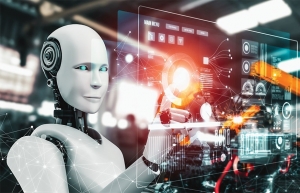The brightest tech trends of 2023
In 2023, the most important tech trends expected to dominate in 2023 include AI and machine learning (ML), 5G, blockchain, and VR and AR, bringing about huge opportunities for businesses to improve processes, improve customers’ experience and lead opponents.
 |
| Hoang Viet Tien - Deputy secretary general Vietnam Digital Communication Association |
AI and ML has made significant strides in recent years and this trend is expected to continue in 2023. AI and ML technologies allow computers to learn from data, improve decision-making, and perform tasks previously performed only by humans. Businesses can tap into AI and ML to automate repetitive tasks, improve customers’ experience, and get valuable insights from data.
In 2023, we will see AI and ML become more transcendent, with particular focus on natural language processing and computer vision. This allows computers to understand and respond to human languages, while computer vision allows computers to perceive and interpret visual information. Therefore, AI and ML will support businesses much to increase operational efficiency.
Elsewhere, 5G is set to revolutionise the way we connect and communicate. With faster speeds and lower latency than 4G, 5G will support new technologies and applications, including the Internet of Things, self-driving cars, and VR/AR.
In 2023, 5G networks are expected to become popular and ubiquitous, providing faster and more reliable connections for a growing number of devices. This will enable businesses to deliver new and improved products and services, increase efficiency, and improve customers’ experience.
In addition, 5G will play an important role in the development of smart cities, providing the necessary infrastructure to connect and manage smart devices, such as traffic lights, and security cameras.
Meanwhile, blockchain, originally developed for cryptocurrencies, has the potential to revolutionise a wide range of industries.
The decentralised and secure nature of blockchain makes it ideal for recording transactions, managing supply chains, and protecting sensitive information.
In 2023, we will see the adoption of this tech continue to grow, with businesses and governments realising its potential to improve processes, reduce costs, and enhance security.
We will also see the development of new blockchain-based applications and the increasing use of smart contracts, which are self-executing agreements with the terms of an agreement between buyers and sellers written directly into lines of code.
VR and AR technologies are set to play an important role in many industries. VR allows users to experience a fully immersive digital environment, while AR enhances the real world with digital information.
In 2023, we expect to see widespread adoption of VR and AR technologies in industries such as gaming, retail, and education. Businesses will be able to use them to deliver new and improved products and services, enhance customer experience, and increase engagement
Additionally, they are expected to play an important role in training and simulation, enabling individuals and organisations to practice and prepare for real-life scenarios in a safe and secure environment.
Current trends are affecting technology businesses, including companies that develop and market tech products and services, as well as those in other industries. However, this effect is not entirely negative and not entirely positive.
These trends include the growth of AI, the growing importance of cloud computing and data analytics, and the emergence of new technologies such as blockchain and quantum computers. These trends are changing the nature of competition in the tech industry, and keeping up with these changes is critical to stay competitive and grow for related firms.
Current trends are also affecting businesses in other sectors such as healthcare, finance, and retail. These trends include the use of telemedicine in healthcare, the increasingly important role of fintech, and the growth of e-commerce in retail. These trends are changing the way businesses in these sectors operate.
Some business sectors such as retail, healthcare, and education are using technology to improve the quality of their services.
Retail businesses have used e-commerce platforms to connect with customers, increase customer convenience, and increase revenue for businesses.
The medical industry has also turned to online consultation services, which help reduce crowds at clinics and hospitals. Doctors and medical professionals can conduct online consultations to make diagnoses and treatment regimens for patients, which enhances professionalism and reduces waiting times.
In the education sector, technology is being used to create new learning experiences for students. Online learning and courses, and mobile learning apps help students learn anytime, anywhere. Lecturers can also use tech to analyse student data and adjust teaching methods accordingly.
However, businesses also face challenges in this area. Companies have to always keep up with new trends so as not to be outdated and lose market share. In addition, the adoption of technology also requires businesses to invest additional costs to update infrastructure and train employees. Information security is another issue as well.
 | AI wave set to sweep tech market The trend for digital transformation and the push from new technology have created momentum for platforms and products applying AI to develop in Vietnam. |
What the stars mean:
★ Poor ★ ★ Promising ★★★ Good ★★★★ Very good ★★★★★ Exceptional
Related Contents
Latest News
More News
- Vietnam’s GDP forecast to grow by 9 per cent in 2026 (December 29, 2025 | 08:29)
- Women entrepreneurs are key to Vietnam’s economic growth (December 29, 2025 | 08:00)
- Vietnam's top 500 value-creating enterprises announced (December 27, 2025 | 08:00)
- The PAN Group shaping a better future with ESG strategy (December 26, 2025 | 09:00)
- Masan Consumer officially lists on HSX, marking the next phase of value creation (December 25, 2025 | 13:20)
- MCH to become the largest consumer stock on VN-Index (December 24, 2025 | 11:05)
- Oil and gas firms post strong 2025 results (December 22, 2025 | 17:42)
- SABECO wins multiple international beer awards (December 22, 2025 | 17:41)
- UOB sees Vietnam growth easing in fourth quarter (December 22, 2025 | 17:39)
- First members of Danang International Finance Centre revealed (December 22, 2025 | 17:39)

 Tag:
Tag:




















 Mobile Version
Mobile Version